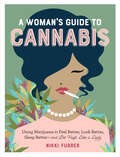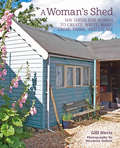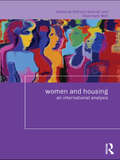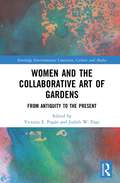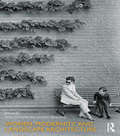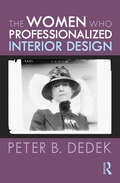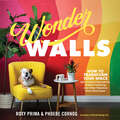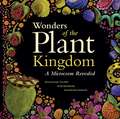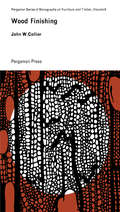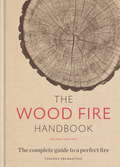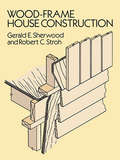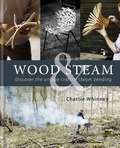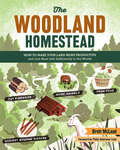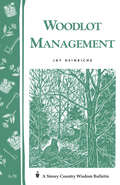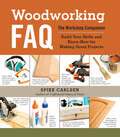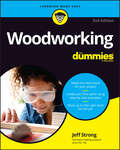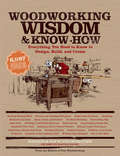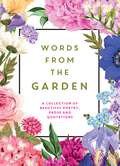- Table View
- List View
Wohnumfeldverbesserungen für Menschen mit Demenz: Bauliche Maßnahmen unter Berücksichtigung komplexer Gesundheitsprobleme (Best of Pflege)
by Christine NaumannChristine Naumann verbindet in ihrem Buch die Perspektiven der Architektur, Pflege und Medizin und setzt bauliche Interventionen mit individuellen Gesundheitsproblemen von Menschen mit Demenz in Zusammenhang. Mithilfe von Anleihen in den unterschiedlichen Berufsgruppen und deren Regelwerken (DIN-Normen, ICF, SGB XI) entsteht ein multiperspektivisches Werk. Ein Maßnahmenkatalog für demenzgerechte Wohnungsanpassung systematisiert das komplexe Wirkungsgefüge von Person und Umwelt und kann die Beratenden unterstützen, die passende Intervention für die Person mit Demenz unter Berücksichtigung individueller Einschränkungen und der baulichen Rahmenbedingungen zu empfehlen.
A Woman's Guide to Cannabis: Using Marijuana to Feel Better, Look Better, Sleep Better–and Get High Like a Lady
by Nikki FurrerA handbook for understanding and using marijuana, written just for women--whether they're using it for medicinal relief or for pleasure. This book is like having a knowledgeable salesperson across the counter at a dispensary who can hand-sell you a product to fit your mood and tastes--because author Nikki Furrer is that person as a producer and distributor of marijuana products to dispensaries. The book answers the questions that Nikki receives from women every week.
A Woman’s Shed
by Gill HerizBecause sheds aren't just for men – this selection of sheds from the UK, North America and Europe shows how women everywhere can claim and use their own personal space.
Women and Housing: An International Analysis (Housing and Society Series)
by Patricia KennettIn the context of contemporary economic, political, social and cultural transformations, this book brings together contributions from developed and emerging societies in Europe, the USA and East Asia in order to highlight the nature, extent and impact of these changes on the housing opportunities of women. The collection seeks to contribute to comparative housing debates by highlighting the gendered nature of housing processes, locating these processes within wider structured and institutionalized relations of power, and to show how these socially constructed relationships are culturally contingent, and manifest and transform over time and space. The international contributors draw on a wide range of empirical evidence relating to labour market participation, wealth distribution, family formation and education to demonstrate the complexity and gendered nature of the interlocking arenas of production, reproduction and consumption and the implications for the housing opportunities of women in different social contexts. Worldwide examples are drawn from Australia, China, Great Britain, Hong Kong, Japan, Spain, Sweden, Taiwan and the USA.
Women and Housing: An International Analysis (Housing and Society Series)
by Patricia Kennett Kam Wah ChanIn the context of contemporary economic, political, social and cultural transformations, this book brings together contributions from developed and emerging societies in Europe, the USA and East Asia in order to highlight the nature, extent and impact of these changes on the housing opportunities of women. The collection seeks to contribute to comparative housing debates by highlighting the gendered nature of housing processes, locating these processes within wider structured and institutionalized relations of power, and to show how these socially constructed relationships are culturally contingent, and manifest and transform over time and space. The international contributors draw on a wide range of empirical evidence relating to labour market participation, wealth distribution, family formation and education to demonstrate the complexity and gendered nature of the interlocking arenas of production, reproduction and consumption and the implications for the housing opportunities of women in different social contexts. Worldwide examples are drawn from Australia, China, Great Britain, Hong Kong, Japan, Spain, Sweden, Taiwan and the USA.
Women and the Collaborative Art of Gardens: From Antiquity to the Present (Routledge Environmental Literature, Culture and Media)
by Victoria E. Pagán Judith W. PageWomen and the Collaborative Art of Gardens explores the garden and its agency in the history of the built and natural environments, as evidenced in landscape architecture, literature, art, archaeology, history, photography, and film. Throughout the book, each chapter centers the act of collaboration, from garden clubs of the early twentieth century as powerful models of women’s leadership, to the more intimate partnerships between family members, to the delicate relationship between artist and subject. Women emerge in every chapter, whether as gardeners, designers, owners, writers, illustrators, photographers, filmmakers, or subjects, but the contributors to this dynamic collection unseat common assumptions about the role of women in gardens to make manifest the significant ways in which women write themselves into the accounts of garden design, practice, and history. The book reveals the power of gardens to shape human existence, even as humans shape gardens and their representations in a variety of media, including brilliantly illuminated manuscripts, intricately carved architectural spaces, wall paintings, black and white photographs, and wood cuts. Ultimately, the volume reveals that gardens are best apprehended when understood as products of collaboration. The book will be of interest to scholars and students of gardens and culture, ancient Rome, art history, British literature, medieval France, film studies, women’s studies, photography, African American Studies, and landscape architecture.
Women and the Collaborative Art of Gardens: From Antiquity to the Present (Routledge Environmental Literature, Culture and Media)
Women and the Collaborative Art of Gardens explores the garden and its agency in the history of the built and natural environments, as evidenced in landscape architecture, literature, art, archaeology, history, photography, and film. Throughout the book, each chapter centers the act of collaboration, from garden clubs of the early twentieth century as powerful models of women’s leadership, to the more intimate partnerships between family members, to the delicate relationship between artist and subject. Women emerge in every chapter, whether as gardeners, designers, owners, writers, illustrators, photographers, filmmakers, or subjects, but the contributors to this dynamic collection unseat common assumptions about the role of women in gardens to make manifest the significant ways in which women write themselves into the accounts of garden design, practice, and history. The book reveals the power of gardens to shape human existence, even as humans shape gardens and their representations in a variety of media, including brilliantly illuminated manuscripts, intricately carved architectural spaces, wall paintings, black and white photographs, and wood cuts. Ultimately, the volume reveals that gardens are best apprehended when understood as products of collaboration. The book will be of interest to scholars and students of gardens and culture, ancient Rome, art history, British literature, medieval France, film studies, women’s studies, photography, African American Studies, and landscape architecture.
Women, Modernity, and Landscape Architecture
by Sonja Dümpelmann John BeardsleyModernity was critically important to the formation and evolution of landscape architecture, yet its histories in the discipline are still being written. This book looks closely at the work and influences of some of the least studied figures of the era: established and less well-known female landscape architects who pursued modernist ideals in their designs. The women discussed in this volume belong to the pioneering first two generations of professional landscape architects and were outstanding in the field. They not only developed notable practices but some also became leaders in landscape architectural education as the first professors in the discipline, or prolific lecturers and authors. As early professionals who navigated the world of a male-dominated intellectual and menial work force they were exponents of modernity. In addition, many personalities discussed in this volume were either figures of transition between tradition and modernism (like Silvia Crowe, Maria Teresa Parpagliolo), or they fully embraced and furthered the modernist agenda (like Rosa Kliass, Cornelia Oberlander). The chapters offer new perspectives and contribute to the development of a more balanced and integrated landscape architectural historiography of the twentieth century. Contributions come from practitioners and academics who discuss women based in USA, Canada, Brazil, New Zealand, South Africa, the former USSR, Sweden, Britain, Germany, Austria, France and Italy. Ideal reading for those studying landscape history, women’s studies and cultural geography.
Women, Modernity, and Landscape Architecture
by Sonja Dümpelmann John BeardsleyModernity was critically important to the formation and evolution of landscape architecture, yet its histories in the discipline are still being written. This book looks closely at the work and influences of some of the least studied figures of the era: established and less well-known female landscape architects who pursued modernist ideals in their designs. The women discussed in this volume belong to the pioneering first two generations of professional landscape architects and were outstanding in the field. They not only developed notable practices but some also became leaders in landscape architectural education as the first professors in the discipline, or prolific lecturers and authors. As early professionals who navigated the world of a male-dominated intellectual and menial work force they were exponents of modernity. In addition, many personalities discussed in this volume were either figures of transition between tradition and modernism (like Silvia Crowe, Maria Teresa Parpagliolo), or they fully embraced and furthered the modernist agenda (like Rosa Kliass, Cornelia Oberlander). The chapters offer new perspectives and contribute to the development of a more balanced and integrated landscape architectural historiography of the twentieth century. Contributions come from practitioners and academics who discuss women based in USA, Canada, Brazil, New Zealand, South Africa, the former USSR, Sweden, Britain, Germany, Austria, France and Italy. Ideal reading for those studying landscape history, women’s studies and cultural geography.
The Women Who Professionalized Interior Design
by Peter DedekThe Women Who Professionalized Interior Design explores the history of interior decorating and design from the late nineteenth century to the present, highlighting the careers and contributions of significant American female interior designers who were instrumental in the creation of the field of residential and commercial interior design in the United States. This book explores how interior design emerged as a distinct, paying occupation in the nineteenth century thanks to a growing middle class and an increase in available cheap household goods following the Industrial Revolution. Focusing primarily on the period from 1905 to 1960, it addresses the complex relationships among professionals in the design fields, the social dynamics of designer-client relationships, and how class, culture, and family influenced their lives and careers. The book emphasizes significant female interior decorators and writers on design including Candace Wheeler, Elsie de Wolfe, Edith Wharton, Nancy McClelland, Ruby Ross Wood, Dorothy Draper, Eleanor McMillen Brown, and Sister Parish, all of whom are underrepresented in the historical record, relating their stories within the context of the history of design and architecture. This book is an ideal and concise resource for students and faculty of interior design and women’s history.
The Women Who Professionalized Interior Design
by Peter DedekThe Women Who Professionalized Interior Design explores the history of interior decorating and design from the late nineteenth century to the present, highlighting the careers and contributions of significant American female interior designers who were instrumental in the creation of the field of residential and commercial interior design in the United States. This book explores how interior design emerged as a distinct, paying occupation in the nineteenth century thanks to a growing middle class and an increase in available cheap household goods following the Industrial Revolution. Focusing primarily on the period from 1905 to 1960, it addresses the complex relationships among professionals in the design fields, the social dynamics of designer-client relationships, and how class, culture, and family influenced their lives and careers. The book emphasizes significant female interior decorators and writers on design including Candace Wheeler, Elsie de Wolfe, Edith Wharton, Nancy McClelland, Ruby Ross Wood, Dorothy Draper, Eleanor McMillen Brown, and Sister Parish, all of whom are underrepresented in the historical record, relating their stories within the context of the history of design and architecture. This book is an ideal and concise resource for students and faculty of interior design and women’s history.
Wonder Walls: How to Transform Your Space with Colorful Geometrics, Graphic Lettering, and Other Fabulous Paint Techniques
by Phoebe Cornog Roxy PrimaThis DIY book teaches wall painting techniques for the creative home-dec enthusiast who wants to create colorful graphic and wallpaper-like designs, including lettering, geometrics, marbling, and more.
Wonders of the Plant Kingdom: A Microcosm Revealed
by Wolfgang Stuppy Rob Kesseler Madeline HarleyCompared to the obvious complexity of animals, plants at a glance seem relatively simple in form. But that simplicity is deceptive: the plants around us are the result of millennia of incredible evolutionary adaptations that have allowed them to survive, and thrive, under wildly changing conditions and in remarkably specific ecological niches. Much of this innovation, however, is invisible to the naked eye. With Wonders of the Plant Kingdom, the naked eye gets an unforgettable boost. A stunning collaboration between science and art, this gorgeous book presents hundreds of images of plants taken with a scanning electron microscope and hand-colored by artist Rob Kesseler to reveal the awe-inspiring adaptations all around us. The surface of a peach—with its hairs, or trichomes, and sunken stomata, or breathing pores—emerges from these pages in microscopic detail. The dust-like seeds of the smallest cactus species in the world, the Blossfeldia liliputana—which measures just twelve millimeters fully grown—explode here with form, color, and character, while the flower bud of a kaffir lime, cross-sectioned, reveals the complex of a flower bud with the all-important pistil in the center. Accompanying these extraordinary images are up-to-date explanations of the myriad ways that these plants have ensured their own survival—and, by proxy, our own. Gardeners and science buffs alike will marvel at this wholly new perspective on the world of plant diversity.
Wonders of the Plant Kingdom: A Microcosm Revealed
by Wolfgang Stuppy Rob Kesseler Madeline HarleyCompared to the obvious complexity of animals, plants at a glance seem relatively simple in form. But that simplicity is deceptive: the plants around us are the result of millennia of incredible evolutionary adaptations that have allowed them to survive, and thrive, under wildly changing conditions and in remarkably specific ecological niches. Much of this innovation, however, is invisible to the naked eye. With Wonders of the Plant Kingdom, the naked eye gets an unforgettable boost. A stunning collaboration between science and art, this gorgeous book presents hundreds of images of plants taken with a scanning electron microscope and hand-colored by artist Rob Kesseler to reveal the awe-inspiring adaptations all around us. The surface of a peach—with its hairs, or trichomes, and sunken stomata, or breathing pores—emerges from these pages in microscopic detail. The dust-like seeds of the smallest cactus species in the world, the Blossfeldia liliputana—which measures just twelve millimeters fully grown—explode here with form, color, and character, while the flower bud of a kaffir lime, cross-sectioned, reveals the complex of a flower bud with the all-important pistil in the center. Accompanying these extraordinary images are up-to-date explanations of the myriad ways that these plants have ensured their own survival—and, by proxy, our own. Gardeners and science buffs alike will marvel at this wholly new perspective on the world of plant diversity.
Wood Finishing: Pergamon Series of Monographs on Furniture and Timber
by John W. CollierWood Finishing provides a comprehensive guide to wood finishing. The emphasis of the book is on tackling practical topics. The text first details the material components of wood finishing, such as strippers, revivers, stoppers, and varnishes. Next, the selection covers the various processes in wood finishing, which include waxing, filling, spraying, and flatting. The next chapter talks about supplementary topics, such as the chemistry of timber, hazards, workshop practices, and testing finishes. The title also tackles the various tools utilized in wood finishing, which include brushes, spray paints, coating machines, and tumbling barrels. The book will be of great use to anyone who wants to expand knowledge in woodworking.
The Wood Fire Handbook: The complete guide to a perfect fire
by Vincent Thurkettle'Sound, well-seasoned advice [on] how to bring wood fires into our lives.' - BBC CountryfileThe Wood Fire Handbook shows you that the soothing effect of dancing flames and glowing embers is a simple pleasure to have in our lives. Understanding everything that underpins the perfect wood fire makes it even more enjoyable. Vincent Thurkettle's handbook is the essential companion and manual.The expert insight and knowledge in this book allow everyone to rediscover the skills of previous generations and savour the delight of a perfect wood fire in all its incarnations.Contents include...Understand which trees make the best firewoodLearn how to split, season, and store woodLay the perfect fireMake an ingenious campfireChoose wood for its scent...and much more!This revised edition features updated information on wood-burning stoves, 'clean' wood and other environmental considerations.
Wood-Frame House Construction: A Do-it-yourself Guide
by Gerald E. Sherwood Robert C. StrohFirst published in 1955 as U.S. Department of Agriculture Handbook No. 73, this highly popular guide presents sound, time-tested principles for wood-frame house construction, complete with expert advice on selecting suitable building materials. For this edition, it has been completely revised and updated to incorporate advances in home building brought about by the availability of new materials, use of more manufactured components, and changes in construction techniques. Chapter 1 covers the preliminaries that should be considered or dealt with before beginning construction ― financial planning, site selection, design, etc.Chapters 2–4 discuss laying the groundwork (including foundations, footings, and retaining walls), framing and closing in ― describing each step in the order it is usually completed. Chapters 5–7 describe later tasks that don't necessarily have to be done in the order they are presented. Topics include porches, decks, interior wall framing, plumbing, heating and electric installation, flooring, interior finishes, cabinets, and more. Chapter 8 covers special topics often associated with wood-frame construction: protection against decay and termites, energy conservation, all-weather construction, maintenance and repair, and other matters. Technical notes, an annotated list of suggestions for additional reading, and a glossary round out the book. Clear, thorough, and easy to follow, with nearly 200 helpful illustrations, Wood-Frame House Construction offers a detailed, informative guide to construction techniques invaluable for the do-it-yourselfer or as a review for the professional.
Wood & Steam: Discover The Unique Craft Of Steam Bending
by Charlie WhinneyIn this beautifully compiled book, Charlie Whinney, the UK's leading expert on the topic, shares the secrets of the unique and magical craft of steam-bending. Although his creations look quite impossible, you will soon discover that wood can be made to behave in remarkable ways with the application of a little heat and steam. Charlie guides you through the ecological sourcing of wood for your projects and then, with practical instructions, reveals how to create your own steam-bent masterpieces. Form a wooden coathanger in the embers of a campfire, create perfectly round wooden hoops using just a saucepan and a mug, or use your new skills to craft a stunning rocking chair.With step-by-step instructions and inspiring photography from Charlie's workshop in the Lake District, this will make the perfect gift for anyone interested in developing a new skill.
The Woodland Homestead: How to Make Your Land More Productive and Live More Self-Sufficiently in the Woods
by Brett McLeodFrom shelter to food to fuel and more, The Woodland Homestead gives you all the tools and information you need to sustainably use your woodlot to its fullest potential.
Woodlot Management: Storey's Country Wisdom Bulletin A-70 (Storey Country Wisdom Bulletin)
by Jay HeinrichSince 1973, Storey's Country Wisdom Bulletins have offered practical, hands-on instructions designed to help readers master dozens of country living skills quickly and easily. There are now more than 170 titles in this series, and their remarkable popularity reflects the common desire of country and city dwellers alike to cultivate personal independence in everyday life.
Woodworking FAQ: The Workshop Companion: Build Your Skills and Know-How for Making Great Projects
by Spike CarlsenWhether you&’re a beginner building your first shelf or an experienced craftsman designing a new gazebo, Spike Carlson has the answers to all of your woodworking questions. You&’ll find expert advice on setting up your work area, choosing appropriate tools, working with different types of wood, and building furniture, as well as tips on joinery techniques, custom finishes, and much more.
Woodworking For Dummies
by Jeff StrongMake stunning furniture, shelves, and more, with this easy guide Woodworking For Dummies gives aspiring woodworkers step-by-step instructions for creating successful woodworking projects. Set your sights on creating beautiful wooden pieces, with your own two hands. Woodworking is a fun and fascinating hobby, and you’ll love developing your skills and enjoying the satisfaction of craftsmanship. This book explains, in simple terms, the basic tools you’ll need, the different types of wood you can work with, and the process of creating plans for a successful project. Start sawing, sanding, joining, and finishing wood projects you can be proud of. One-of-a-kind, handmade woodcrafts are excellent as additions to your home and gifts for others, and you can even start a small business selling your handiwork. This For Dummies primer makes this cool activity accessible to anyone. Start a new hobby, work with your hands, and see your visions come to life Learn about classic and cutting-edge woodworking tools Differentiate between the different kinds of wood and select the right materials for your project Become a woodworker with easy-to-use photos and instructions Even if you’ve never picked up a saw before, this For Dummies guide will help you get started—and it’s a great reference and refresher for those who already know what they’re doing, too.
Woodworking For Dummies
by Jeff StrongMake stunning furniture, shelves, and more, with this easy guide Woodworking For Dummies gives aspiring woodworkers step-by-step instructions for creating successful woodworking projects. Set your sights on creating beautiful wooden pieces, with your own two hands. Woodworking is a fun and fascinating hobby, and you’ll love developing your skills and enjoying the satisfaction of craftsmanship. This book explains, in simple terms, the basic tools you’ll need, the different types of wood you can work with, and the process of creating plans for a successful project. Start sawing, sanding, joining, and finishing wood projects you can be proud of. One-of-a-kind, handmade woodcrafts are excellent as additions to your home and gifts for others, and you can even start a small business selling your handiwork. This For Dummies primer makes this cool activity accessible to anyone. Start a new hobby, work with your hands, and see your visions come to life Learn about classic and cutting-edge woodworking tools Differentiate between the different kinds of wood and select the right materials for your project Become a woodworker with easy-to-use photos and instructions Even if you’ve never picked up a saw before, this For Dummies guide will help you get started—and it’s a great reference and refresher for those who already know what they’re doing, too.
Woodworking Wisdom & Know-How: Everything You need to Design, Build and Create (Wisdom & Know-How)
by Taunton PressFrom the experts at Fine Woodworking magazine, this complete and easy-to-follow resource has everything you need to know about the art of woodworking.Woodworking Wisdom & Know-How is the essential go-to book for every woodworking project imaginable, from building kitchen cabinets to refinishing a deck, from the vast cache of Fine Woodworking's projects and advice.Topics addressed in this book include:Types of WoodBuilding a WorkshopWorking and Finishing WoodDesign and StylesSmall and Large ProjectsEach section is further broken down into chapters that cover specific skills, projects, and crafts for both the beginner and the advanced woodworker. Featuring step-by-step instructions, troubleshooting guides and discussions, and an appendix of essential resources for supplies, tools, and materials, Woodworking Wisdom & Know-How is your one-stop-shop for trusted, tried, and true woodworking advice.This book is also a part of the Know-How series which includes other titles such as:Country Wisdom & Know-HowNatural Healing Wisdom & Know-HowCraft Wisdom & Know-HowGarden Wisdom & Know-How
Words From the Garden: A Collection of Beautiful Poetry, Prose and Quotations
by Isobel CarlsonThis beautiful collection of poetry and prose through the seasons rhapsodises on the spectacle of colour and everything green and flourishing in the garden. The perfect book for a moment’s reflection, whether you are cooped up on a rainy day in your potting shed or admiring the fruits of your labour on a sunny evening from the pergola.

